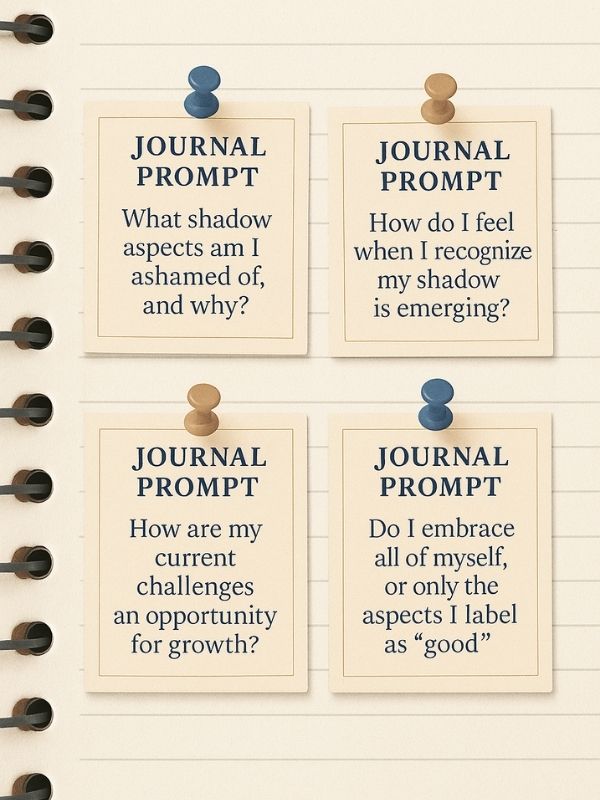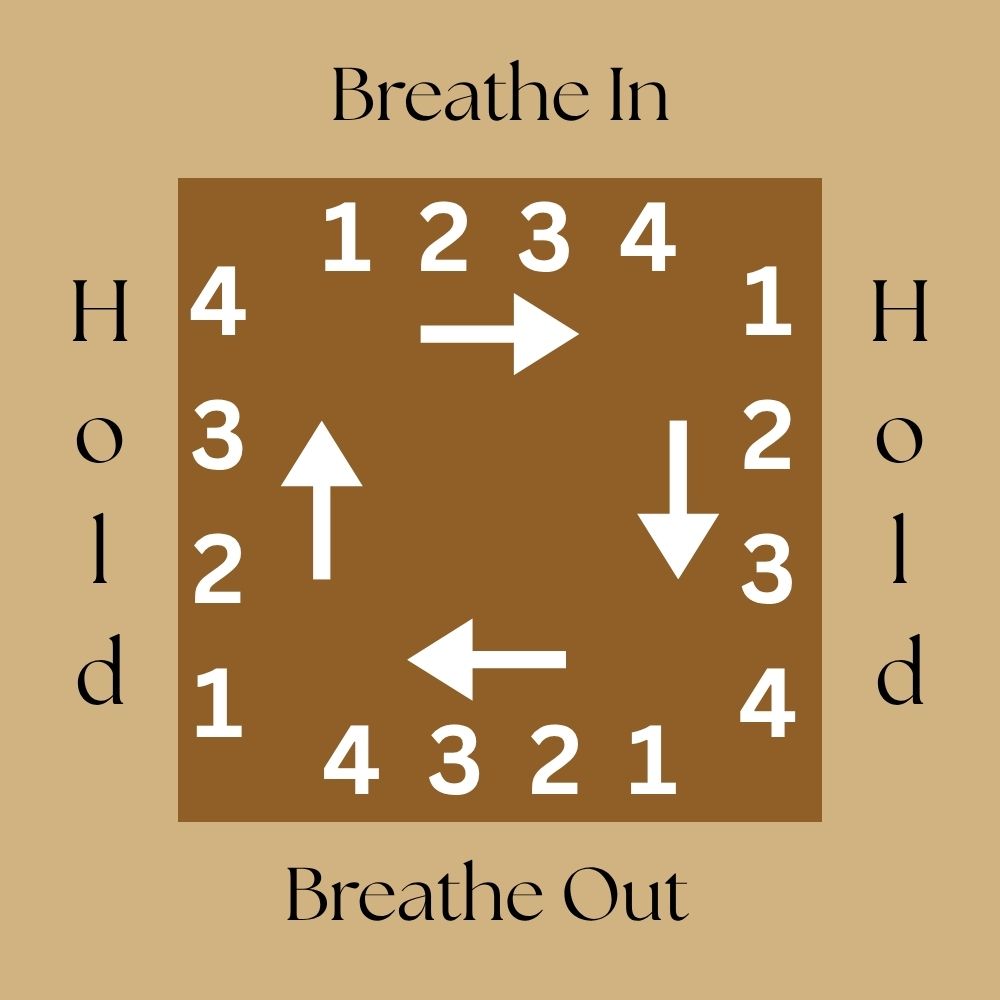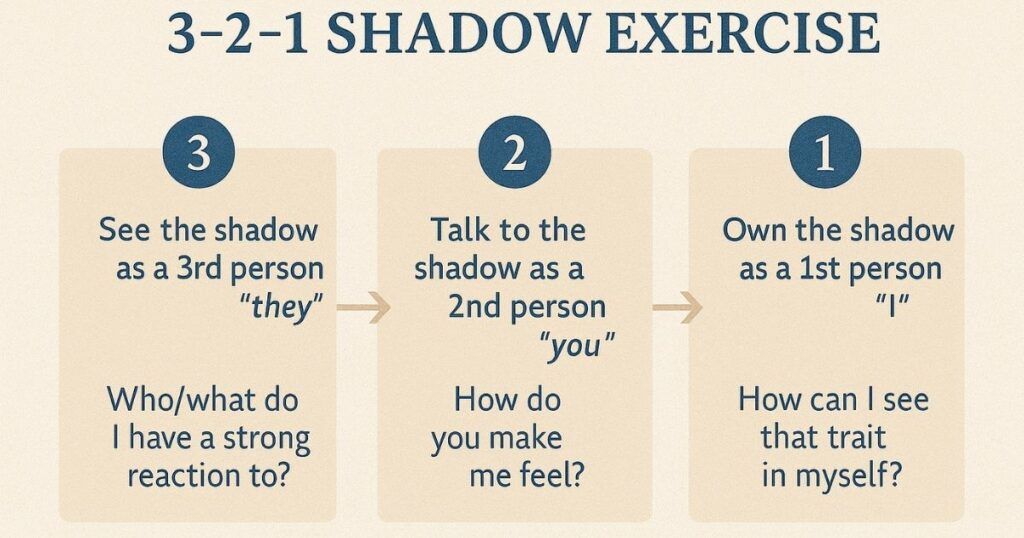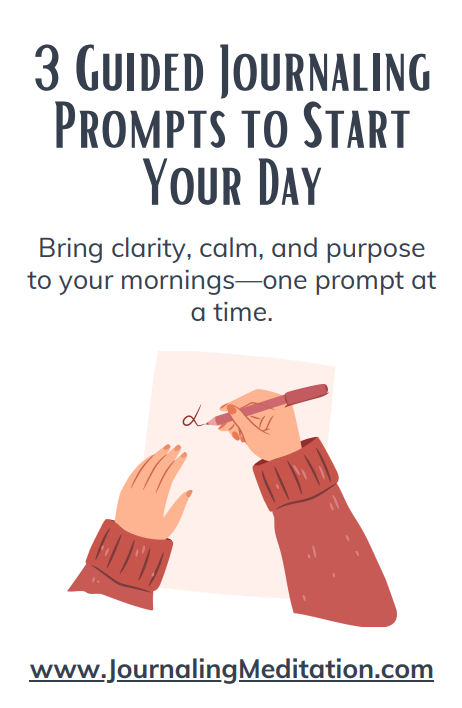
What Is Shadow Work?
Rooted in the psychology of Carl Jung, shadow work refers to the process of uncovering and integrating the hidden or repressed parts of ourselves. These are usually areas of ourselves we keep hidden due to fear, shame, or expectations. For beginners, starting with structured, mindful shadow work exercises and practices is essential to navigating this inner journey with safety and compassion.
Shadow work exercises are a powerful tool for beginners seeking growth, healing, and a greater self-understanding. By exploring the hidden or “unwanted” parts of ourselves, also known as the “shadow”, we can start to uncover unconscious patterns that shape our thoughts and behaviors. This process can be difficult, challenging, and even painful. But it can also be incredibly rewarding, opening the door to deeper self-acceptance and untethered growth.
Shadow work is not about fixing what is broken, but about discovering, accepting and eventually embracing All of it, good and bad. When we deny our shadow, it works behind the scenes and controls our behaviors and reactions. Through exercises like journaling, meditation, and creative expression, we can start to explore our inner selves and and bring our wholeness forward.
Understanding the Framework of Shadow Work
The Mind–Body–Emotion Connection
Our shadows manifest not only in our thoughts but also through our emotions and how we feel. For instance, regular anxiety or tightness in the chest may be an indicator of unresolved fears or suppressed anger. Becoming aware of connections is a cornerstone of effective shadow work.
Core Principles of Shadow Work

- Awareness: Observe thoughts and behaviors that bring up discomfort or overreaction.
- Acceptance: Allow difficult emotions to surface without judgment or reaction.
- Integration: Consciously bring hidden, unwanted parts of ourselves into the light to understand the good they may offer.
Creating a Safe Space to Begin
Setting the Environment
Before jumping into the turbulent pool of shadow work exercises, create a space that feels safe. Find a quiet area that is regularly free from distractions, something yours. Light a candle or burn incense to set a ritual for the start of your sessions. Use lavender’s natural relaxing effect and our olfactory memory to your advantage. Soft background music can also help create a calming and relaxing atmosphere.
Tools You’ll Need
- A dedicated shadow work journal. Any type of journal or writing pad will work, but I like having a dedicated journal for work like this. Having a nice, specific journal really helps with reflection.
- Pen or digital note app. I prefer writing with pen because I like the physical feel of the pen and power it can have. But if an App works for you, use it.
- Timer (optional, for structuring sessions). This can be a simple cooking timer or just your phone. No need to get fancy (unless you want to).
- Grounding object (like a crystal or calming stone). These can be a visual or physical reminder to bring you back to the present moment.
Setting an Intention
Start each session with a clear intention. This will give you clear focus on the purpose. Some helpful examples include:
- “I welcome all parts of myself.”
- “I am safe to explore my inner world.”
- “I trust what surface in this session.”
These intentions can also help serve as an anchor, giving you the intention to come back to, if needed.
Shadow Work Exercises for Beginners
Guided Shadow Meditation
Meditation is a powerful, yet gentle way to access the shadow, when we’re ready. Begin by focusing on your breath for a few minutes. Once you feel calm and open, invite any uncomfortable feelings or memories to come up. See them without engaging. In this moment, ask yourself: “What part of me needs attention right now?”
Do not judge or criticize the answer. The point is to get an answer without attached expectations or discriminations. The answer introduces you to the parts of you that need and deserve attention.
Journal Prompts & Emotional Inquiry
The great thing about journaling is it creates a safe space for open shadow exploration. You are the only one that needs to see or even know about your journal. Try some of these prompts to explore deep into your self:
- What qualities in others irritate me most. Why?
- When was the last time I felt deep shame or embarrassment?
- What part of me do I try to hide from others?
- What do I fear people would see if I were fully myself?

How to Structure Your Session:
- Select a prompt.
- Set a timer for 3-5 minutes.
- Write without thinking about what to write or censoring.
- Reflect: What areas of myself are there opportunities to explore? Did I discover something new about myself?
Inner Child Letter
Writing to your younger self can help uncover wounds and bring unmet needs to the surface. These suppressed areas can form core shadows. (When dealing with trauma, abuse or anything that may be unbearably painful, I strongly recommend professional help to assist you in this process.)
Example:
Dear Little Me,
I remember you and I see you. Curious, sensitive, always watching and trying so hard to be good enough, even when things didn’t make sense. You carried so much on your small shoulders. And you did it so quietly, thinking maybe if you were just a little better, things would get easier.
You didn’t deserve the confusion, the loneliness, the lies or the moments you felt invisible. You weren’t too much. You were always enough. You were just a child, doing your best with what you had.
I’m here now. I’m the grown-up version of you, and I finally understand just how brave you were and I’m sorry you had to hold it all in. You don’t have to anymore. I’m here to help.
I love you. Unkept hair, big heart, anxious thoughts and all. You were never broken. And you’re not alone.
Love always,
Me
Read this, or your own version, to yourself aloud. Or if you have a regular practicing space or alter, place it in view as part of your integration ritual.
The Physics Of Practice: Shadow Dance and Breathwork

Expressive movement can help release trapped emotions and can represent something indescribable. As awkward as it may sound, why not? Try:
- Shadow Dance: Put on music and allow your body to just move, especially when experiencing frustration or grief. This can be very therapeutic.
- Breathwork: Use rhythmic breathing techniques (like 4-4-4-4 Box Breathing technique) to ground before, after or even during heavy shadow sessions. It’s perfect for calming down, reducing stress and improving focus.
Creative Expression
Art bypasses the rational mind, giving us a direct path to the unconscious. Jung saw and expressed this with his authoring of The Red Book. Try these exercises:
- Draw your shadow self: This is for pure representation, with no right or wrong outcome. Don’t worry about skill. Just focus on expression.
- Make a collage: Use magazine cutouts or print pictures from software programs like Canva or Adobe to visually express your inner darkness or fears.
Structuring Your Practice Over Time
Weekly Practice Schedule
Start small to avoid being overwhelmed. When first starting out, consider giving yourself an opportunity to reboot after each session. Take a day to reflect before moving on to the next process.
For example:
- Monday: 10-minute guided shadow meditation. You will probably want to journal following the meditation, but don’t feel obligated.
- Wednesday: Explore a deep journal prompt related to your guided meditation. Reflect on what came up over the last couple days
- Saturday: Release tension or built up anxieties through expressive art or a shadow dance session.
Tracking Insights
Use a journal to log and track both your journey and progress. This is a great way to watch variations of yourself develop and also express compassion for yourself through this process. Some example columns might be:
- Date
- Shadow work exercise used
- How do I feel?
- Prompt, desired insight or question
- Reflect on the entire experience
When to Seek Professional Support
Shadow work can unearth painful memories or trauma. It’s okay and often necessary to seek professional help.
- Signs you may need help: Intense overwhelm, dissociation, or frequent shutdowns. The best way to gauge? If the discomfort feels too unbearable, please talk to a professional.
- Consider therapists trained in trauma-informed care or Jungian psychology. Finding the right one is important, too.
Advanced Shadow Tools to Explore Later
1. Dream Journaling
This may be the number one go-to for a reason. Our dreams, also the subconscious, don’t play by the same rules as our “awake” minds play by. The subconscious speaks in metaphors, archetypes, and WILL exaggerate or distort that which we are aware of. That’s why keeping a dream journal can be so helpful and revealing.
How to Do It:
- Keep a notebook or voice recorder within arm’s reach of your bed.
- As soon as you wake up and before getting out of bed, write down everything you remember. Even fragments can be significant. It may help bring about a significant memory or reasons for a recurring thought.
- Pay attention to recurring themes, people, settings, and especially and the feelings.
- Ask yourself: What part of me might this represent? For instance, if a bear chases you in a dream, it probably isn’t about bears. It could represent suppressed anger, power, empathy, or fear.
Why It Works:
Carl Jung, who developed the concept of our shadows, also saw dreams as a path to the subconscious. When you journal dreams regularly, you start to spot the characters and patterns that represent areas we reject of ourselves. Knowing these areas allows us to work on them.
2. Synchronicity Tracking
Synchronicities are those weird little “coincidences” that seem too meaningful to ignore. Like thinking of an old friend you haven’t talked to in years and then getting a text from them minutes later.
How to Do It:
- Start a section in your journal just for synchronicities you pick up. Maybe a section at the very end.
- Record the date, what happened, how it made you feel, and any thoughts or situations that were on your mind at the time.
- Look back weekly: Are certain symbols, numbers, or people popping up again and again? Explore the significance you may see in these patterns.
Why It Works:
Synchronicities may highlight topics we’re not consciously addressing but should. If the same kind of event keeps recurring, it may be your a part of your shadow asking for your attention. For example, repeated run-ins with angry strangers could be pointing you toward your own unaddressed anger.
3. Role Reversal Writing
This one’s powerful. And can be a bit uncomfortable. But that’s the point. It’s a tool to uncover the judgments, projections, and old wounds we put onto others.
How to Do It:
- Choose someone who gets under your skin. Not someone who’s abusive, but someone who reliably triggers you.
- Write a page or two from their perspective. Try to be them. What do they believe? What drives them? Maybe even explore what pains and burdens they are carrying.
- Don’t try to understand, justify or even label their actions. Just try to understand them.
Why It Works:
When we write from someone else’s perspective, especially someone we dislike, we often discover parts of ourselves we’ve disowned or at the very least ignored. That judgmental coworker might our own suppressed perfectionism. That needy friend? Maybe a part of us feels shame for needing too much.
These tools aren’t just introspective. They are transformative. They help us meet our shadow not with fear, but with curiosity and an open heart. If you want a deeper relationship with yourself, these practices are a great place to start.
People Also Ask
Shadow work can feel like trying to navigate an emotional rollercoaster inside a labyrinth. The ups and downs along with not knowing what to expect is exhausting. Here are some frequently asked questions people look up when they’re thinking about trying it:
How do you practice shadow work?
Start by keeping track of emotional triggers and journaling your thoughts and feelings about them. Follow up with meditative reflection or expressive art.
For those looking to go more in depth, maybe a structured shadow work journal with prompts like “In what ways do I seek validation or approval from others?”
No matter what you choose, having a non-judgmental mindset showing up every day are key.
What is the 3-2-1 shadow exercise?

The 3-2-1 method involves three steps:
- 3rd Person: Describe the shadow (it can be a trait, someone specific, or situation) from an outsider’s perspective.
- 2nd Person: Engage with it directly. Write to it or speak with it. Writing is powerful for reflection.
- 1st Person: Integrate it by journal on how it is part of you. Where do you see it?
This method brings awareness, dialogue, and unification into one powerful exercise.
What are good shadow work prompts?
A good prompt can lead you to say more than you thought was possible or intended. Some effective prompts include:
- “When do I feel most insecure, and why?”
- “What do I judge in others that I secretly dislike in myself?”
- “What belief about myself limits me the most?”
These questions can open you up to deep reflection and peel back layers that can reveal hidden parts of your psyche.
How do I figure out what my shadow is?
Observe, without judgement, your emotional reactions, especially anger, envy, or fear. Notice who or what bothers you try to discover why. These reactions often point to things like traits we dislike, parts of us we are embarrassed about or even buried pain. Journaling and mindfulness can help uncover recurring roadblocks and obstructions.
What’s the best way to start shadow work if I’m nervous?
Begin with short, guided meditations or simple journaling. Focus on building a safe space and gentle routine. Remember, it’s okay to go slow and often works best. Each small step opens more space for healing.
Remember To Embracing the Journey
This articles introduction of shadow work exercises for beginners is put together so you can provide a structured, compassionate way to explore your dark corners and reclaim your power. Through meditation, journaling, movement, and art, you can uncover hidden and repressed parts of yourself and begin to weave them into your daily life. As you continue this journey, remember that each insight is a step toward greater freedom, authenticity, and healing.
You are not broken. You are discovering your pieces and becoming whole.
For more tools and insights into shadow work, explore Psychology Today’s guide to the shadow self.
We’d love to hear from you! What shadow work exercise resonated most with you? Drop a comment below and share your experience or any questions you may have. Thanks for reading!






